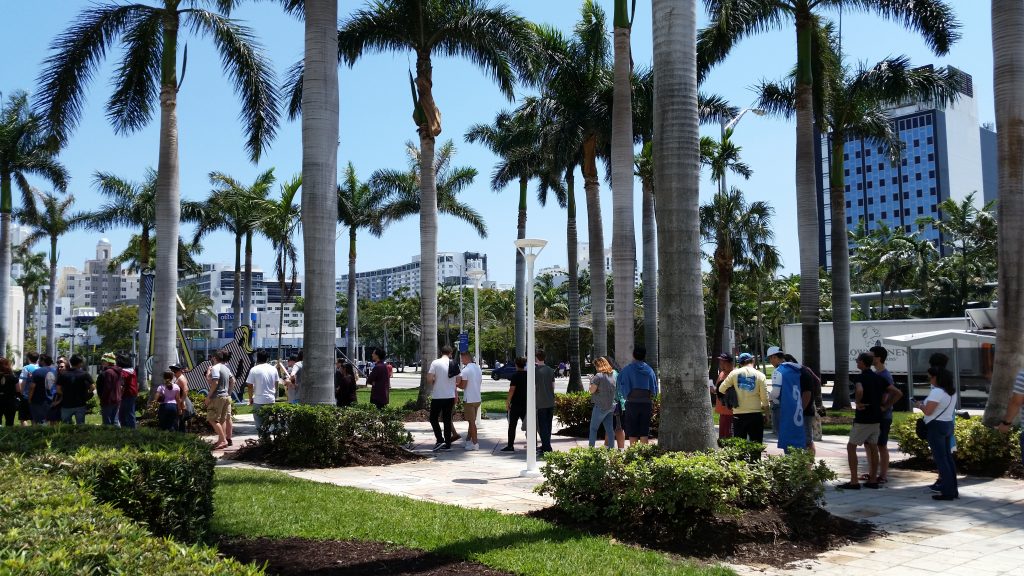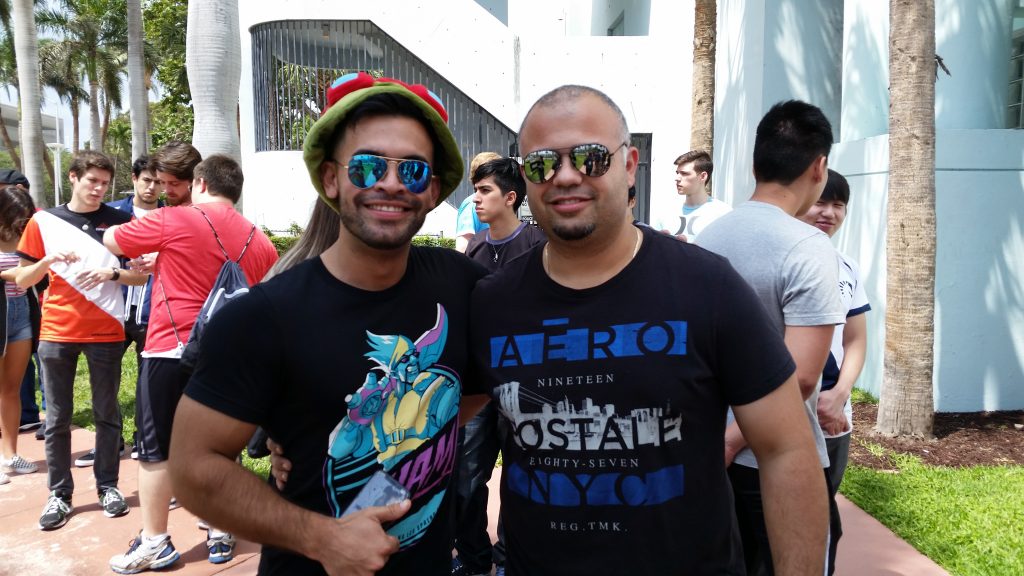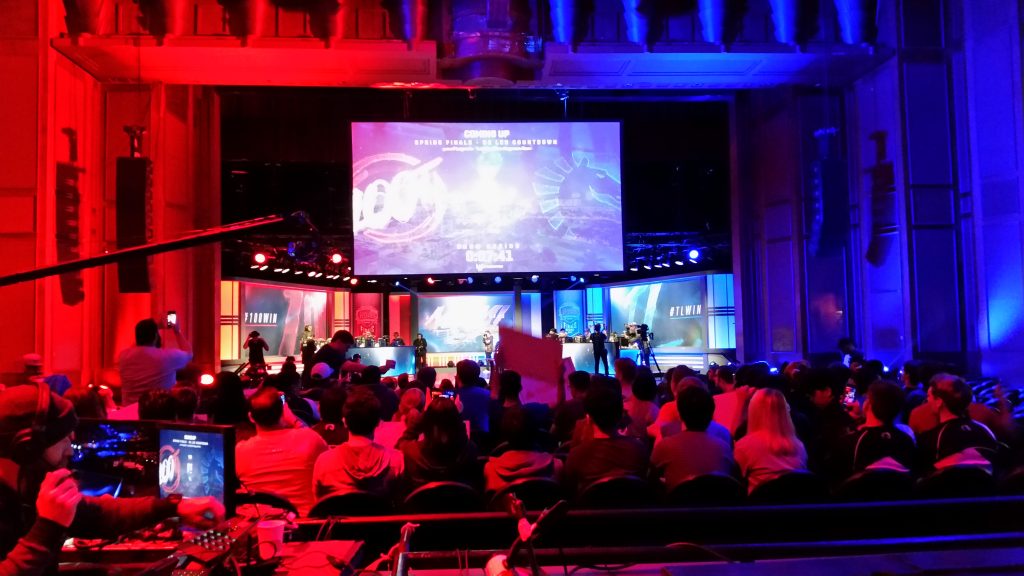The first thing you notice about The Fillmore Miami Beach at the Jackie Gleason Theater is its name. Before setting eyes on its Art Deco marquee, entering the gorgeous double-decker foyer, or settling into red seats among red drapes, you’re confronted by this mouthful of a name.
How to break it down? The Jackie Gleason part seems clear; his picture hangs around every corner (in honor of his eponymous 1960s variety show). We’re in Miami Beach, so that makes sense, and this space could be mistaken for nothing but a theater. Yet no one here considers those monikers when referring to the venue. Gleason’s been dead longer than the players who took his stage one April weekend have been alive, and this isn’t the only theater in Miami Beach.
To me, and everyone else I spoke to at the 2018 NA LCS Spring Finals, we were at The Fillmore. Strange, because The Fillmore is located over 3,000 miles away in San Francisco, California.
Where the hell were we?
Live Nation Entertainment—the conglomerate responsible for Ticketmaster and JAY-Z’s Roc Nation—acquired the Jackie Gleason Theater in June 2007. After the contract was signed, they sent out a press release with the subtitle “Deal Expands Live Nation’s Fillmore Venue Brand to Sixth Major Market in U.S.” It was true—Miami Beach joined a cadre of cities across the United States with its own Fillmore.
One of Live Nation’s first acts was subordinate the Miami theater’s history inside its own name. The original Fillmore theater—a Bay Area launchpad for several famous 1960s counterculture bands you’ve never heard of (but your parents have)—conveyed such gravitas and significance that it deserved to be replicated. Miami Beach was no exception.
Implicit in the rebranding was an established hierarchy of live experience: The Fillmore brand came first, under the assumption that it was worth more. Gleason and his fellow ghosts got second billing, subsumed by the brand of another, suddenly indistinguishable from the larger organism despite being trotted out for local appeal. Every piece of the theater’s history, those Golden Age luminaries and touring Broadway shows, became a part of the Fillmore brand.
When it reopened on October 11, 2007, after a $3.5 million-dollar renovation, The Fillmore Miami Beach at the Jackie Gleason Theater had a look to suit its name. The new red-on-red aesthetic would have been familiar to anyone who had visited its OG SF parent, but the branded features didn’t stop there. According to custom, buckets of fresh red apples were provided at the door for any concertgoer, free of charge. Apples, in a state famed for its oranges. It’s the Fillmore, after all.
The line began forming outside hours before The Fillmore’s doors opened, snaking around the box office and down 17th St. I spoke to some of the waiting fans as they stood underneath the palm trees. I wondered how Riot’s experimental choice of venue was impacting their experience, if at all.
Most were local, hailing from nearby Boca Raton, Coral Springs, Fort Lauderdale, or Miami itself. I met a couple with matching Cloud9 shirts who were excited for the weekend’s action despite their favorite team’s absence. Some were a mix of out-of-towners and their local friends. Two old FAU college buddies reunited for these finals after one moved to Cleveland. All were happy that a League event popped up close by, and they jumped at the chance to support the game they loved. If the Fillmore’s history impressed them, no one told me.
Well, no one except Alex, a veteran of four NA LCS finals who flew in from Washington D.C. A longtime C9 fan, he attended incognito underneath William “Meteos” Hartman’s old Phoenix 1 jersey. For him, Riot’s choice of venue was a surprise.
“I was originally hesitant like everyone on Reddit at first,” said Alex. “‘Why are you doing a 2,000 seat venue compared to these 20-30,000 seat arenas? Why can’t we do that?’ But to be fairly honest, I like genuinely like the 2,000 seat. It’s much more personal. The way they’ve even decorated the place in the theme of the city has been fantastic, something I feel the venues in the past didn’t really do. They tried to capture the whole feel of Miami in this venue. And knowing how historical the venue is as well, I can’t think of a better place to have the finals.”
Riot’s emphasis on creating a Miami vibe was present in every décor choice: Miami Vice lettering, neon blue/pink color palette, white limos, a red carpet, and a side-scrolling arcade game where Lucian and Garen took the place of Crockett and Tubbs. The feeling wasn’t lost on the locals. Miami natives Enrique and Gabe appreciated Riot’s effort, but for them, the feeling transcended any specific design.
“It’s more the Miami style,” explained Gabe. “More close to our roots, our culture. Wild, a lot of screaming. Today, I’m sure there’s going to be more screaming.”
“This is actually the second time I’ve been to an event like this,” said Enrique. “MSI Tallahassee, that was my first event and it was amazing. But here in Miami, it feels way better.”
The 2015 Mid-Season Invitational—held on the campus of Florida State University—was a common touchstone among the Florida fans I spoke to. To them, the intimacy of the Fillmore stood in stark contrast to the 12,500 Donald L. Tucker Civic Center seven hours to the north. “This one’s smaller for sure,” said Alvaro, a member of Super League Gaming’s Miami Menace. “But I feel like there’s more to do when we get inside compared to MSI. When we got in [at MSI], we just went in and sat down. Here, we got to meet the teams beforehand, made our signs, just more interaction.”
“It’s nice that there’s less people than there normally is at these kind of things,” said Andrew, who had come to Orlando with several Liquid-loving friends. “I went to MSI a few years ago at FSU in Tallahassee, and there was way more people, everything was crazy. This venue’s smaller, so it’s not as crazy when you’re trying to leave.”
Given the opportunity to attend another small-scale NA LCS final, Alex would be open to it. “For Spring, definitely, because it’s kind of an awkward time slot,” said Alex. “Some people are in college, some people are still working, whereas summer you can have more fun with it. People are much more willing to shell out money for a summer vacation or something like that. In the summer, if we want to do Madison Square Garden or Barclays, Capital One Arena or TD Garden, whatever it is I’d recommend that. But for Spring, yeah, have stuff like this.”
It seemed fitting that an NA LCS split dominated by the introduction of franchising should end inside a franchise. The Fillmore’s orchestra seating ceded room for the State Farm Analyst Desk. Three teams competed at their first finals; two were brand new to the league, and a fourth had been relegated twice the season before. All four participants were backed by billion-dollar traditional sports organizations (or, in Team Liquid’s case, an equally wealthy group of investors), and none would have made their playoff runs without them. New money permeated the air, and nowhere was it more apparent than the rosters.
Franchising the NA LCS was a boon to well-monied outsiders and influential endemics; the former was finally able to invest in the coveted esports audience, and the latter cashed in on years of risky business. But as the big brands moved in, some historic names were forced out. Four teams lost their lives during the application process, including one of the founding members of NA LCS. Stronger orgs swept away the weak with an avalanche of money, blurring the line between team and brand. Players that suddenly found themselves without a team didn’t stay homeless for long, and the league moved on.
It was surprising, then, to see Immortals, Team Dignitas, Phoenix 1, and Team EnVyUs headline Spring Finals after being so recently buried. Of the 20 players that took the Fillmore’s stage, 13 of them played for one of those four defunct teams last season. In the third-place match, Echo Fox—the stylistic heirs to Team Dignitas—competed with Dig’s old bot lane against a team many had nicknamed “Envy 2.0.” Likewise, three out of Liquid’s championship five came from Noah Whinston’s Immortals, and their finals opponent answered the thought experiment: What if Spring 2017 Phoenix 1 had a world-class support AND started William “Meteos” Hartman in the playoffs?
This appropriation begs the question: Who won Spring Split? Was it Team Liquid, the first-place finishers who hoisted the NA LCS trophy as sticky silver confetti coated the theater? Was it Liquid’s co-owners Steve “LiQuiD112” Arhancet and Victor “Nazgul” Goossens for shrewdly scooping up five former Immortals players the moment they became available, then signing Yiliang “Doublelift” Peng and Jung “Impact” Eon-yeong to massive three-year deals? Was it Noah Whinston, who melded Liquid’s core into a world-class trio, only to watch his organization be stripped from the league? Maybe it was Counter Logic Gaming won despite failing to qualify for playoffs; after all, they were the first to unite Doublelift, Jake “Xmithie” Puchero and Eugene “Pobelter” Park years ago. You could even make an argument for 100 Thieves, a team that made a final and established a loyal—albeit merch-less—fanbase in the span of one split.
All of those answers are incomplete, and their insufficiency points to the real Spring Split victor: Franchising. The choice to franchise the NA LCS gave Team Liquid—coming off two tumultuous years of dysfunction and underachievement—the chance to buy the players they needed. Suddenly, Liquid became kings of the region. One of the biggest brands in all of esports finally found success in League of Legends. Without franchising, who knows how long Liquid could have stayed afloat in NA LCS, burning through money while continuously chasing the next big import contract. Now that the money is right, all worries have been tranquilized. Have you seen their new training facility?
The ghosts of NA LCS past are now commanded by Liquid and other brands like them, superior enough to pass Riot’s testing and strong enough to engender investment. Aren’t we all better off?
During the last day of Spring Finals, I met a young producer on a fact-finding mission. She came on behalf of a major television network you’ve heard of, and ostensibly wanted to learn how best to cover the emerging force known as “esports.” All the young people were watching, and she was finally able to convince her bosses that covering these events might be a way to court a valuable demographic.
We watched the first two games together, front row of the central orchestra seats. As Xmithie turned around Game 1 with a stunning Baron steal, and Pobelter dropped jaws with a four-man Shurima Shuffle, I learned that she was a gamer in disguise. The network’s mission was real, but as a Plat ADC, it also was a pretext to see her favorite game live. It was a reassuring thought: One of ours was undercover among the stodgy old TV executives, fighting for our sport to gain wider coverage and acceptance. I’m sure she’s not alone in the fight.
And then I realized: This is how esports is going to grow. It’s going to be dragged in front of the older generation, armed with numbers and enthusiasm, by people like this producer, people who know about the tidal wave of change this generation will bring once it ages into power. Time is in our favor. Esports aren’t a secret to anyone under 35; their popularity is self-evident. But to everyone else, it’s like looking at The Matrix and seeing only lines of green code. What is this thing called esports? With our help, they’ll understand.
This producer’s mission is proof that conversion is happening right now. Old eyes are cottoning on to the youth’s pursuits, and they see dollar signs. Soon, the mainstream is going to come calling. Esports won’t stay in its niche for long; its fanbase is growing too rapidly, and the road to making a living as an esports athlete is becoming more accessible. Will we be ready for our closeup?
Franchising the NA LCS is the first step, a chance for big companies to test the waters. They’ll soon discover what we already know: Esports isn’t going anywhere. The bubble isn’t going to burst. The games will come and go, but the audience, the interest? That will endure and prosper. A generation raised on esports isn’t suddenly going to leave the scene behind.
The brands, the sponsorships, the money; they’re coming. One day, we will wake up and find that our sport has been branded by a rich conglomerate, and that might be a good thing. Our role as natives is to determine what kind of sport we’re going to be, and what history is preserved after deep-pocketed outsiders envelope the whole enterprise.
Franchising can change the name of a building. It can renovate the insides, redo the exterior, and reupholster the furniture. But franchising cannot alter history, unless we let it. Little things matter, like Riot’s reverence to the locality at these finals, or a collective remembrance of the teams that have come before. As the body changes, it’s our job to remember the soul.
The NA LCS can be found streaming on Twitch, YouTube, and at lolesports.com.







